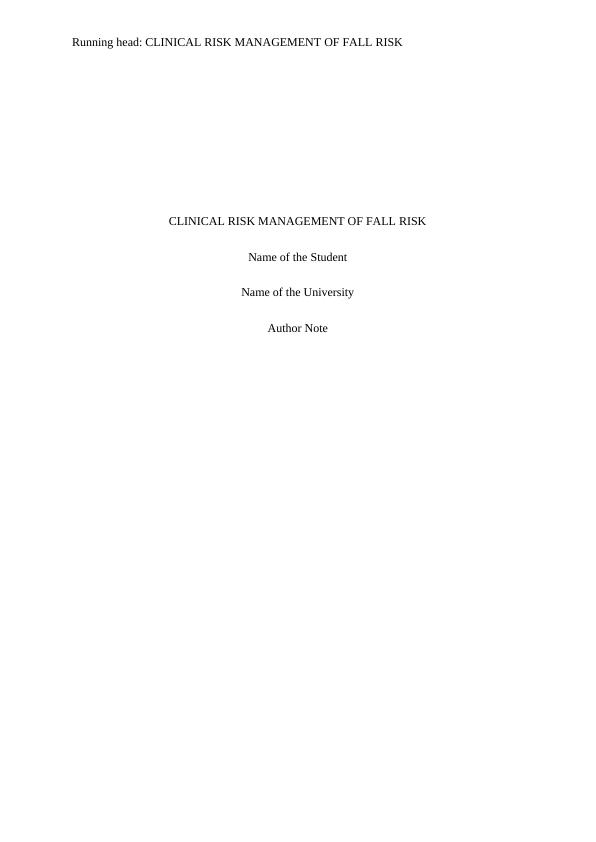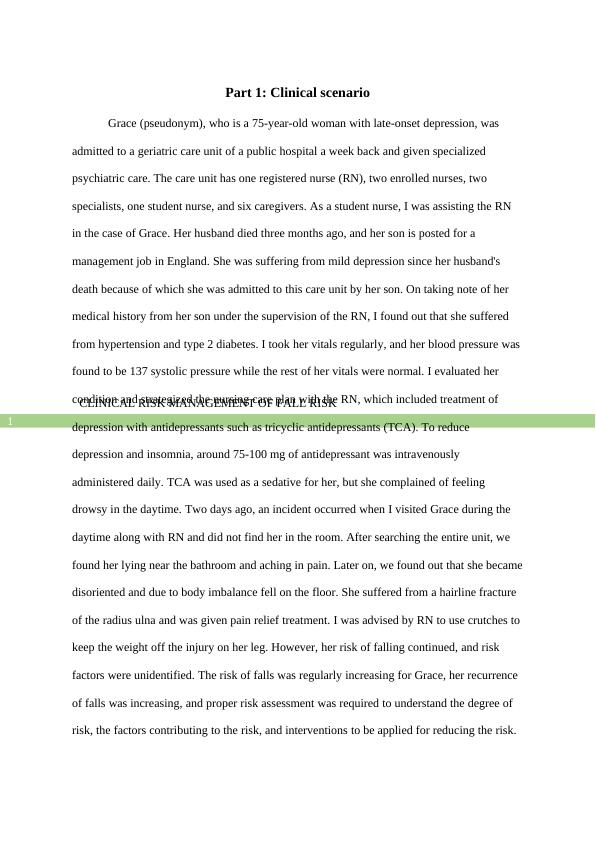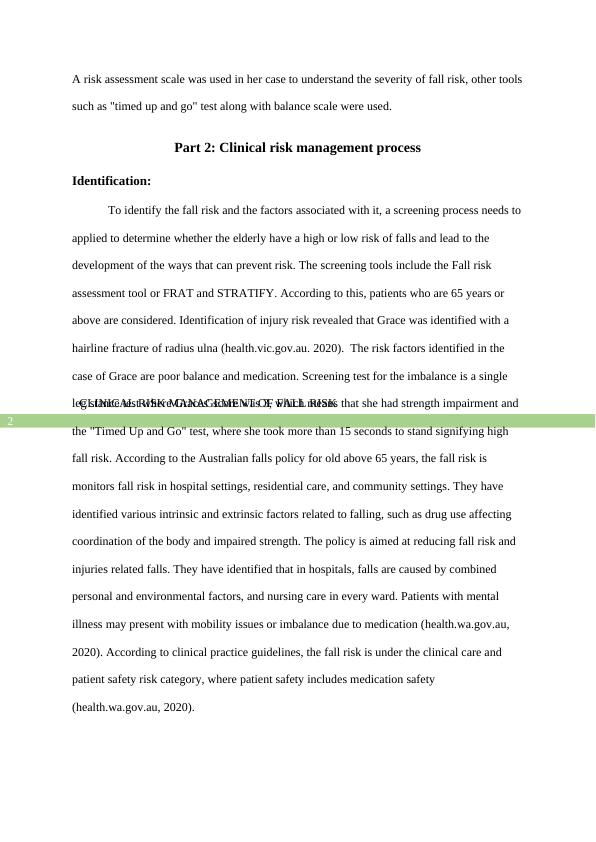Clinical Risk Management of Fall Risk | Assignment
Added on 2022-08-25
9 Pages2489 Words44 Views
Running head: CLINICAL RISK MANAGEMENT OF FALL RISK
CLINICAL RISK MANAGEMENT OF FALL RISK
Name of the Student
Name of the University
Author Note
CLINICAL RISK MANAGEMENT OF FALL RISK
Name of the Student
Name of the University
Author Note

CLINICAL RISK MANAGEMENT OF FALL RISK
1
Part 1: Clinical scenario
Grace (pseudonym), who is a 75-year-old woman with late-onset depression, was
admitted to a geriatric care unit of a public hospital a week back and given specialized
psychiatric care. The care unit has one registered nurse (RN), two enrolled nurses, two
specialists, one student nurse, and six caregivers. As a student nurse, I was assisting the RN
in the case of Grace. Her husband died three months ago, and her son is posted for a
management job in England. She was suffering from mild depression since her husband's
death because of which she was admitted to this care unit by her son. On taking note of her
medical history from her son under the supervision of the RN, I found out that she suffered
from hypertension and type 2 diabetes. I took her vitals regularly, and her blood pressure was
found to be 137 systolic pressure while the rest of her vitals were normal. I evaluated her
condition and strategized the nursing care plan with the RN, which included treatment of
depression with antidepressants such as tricyclic antidepressants (TCA). To reduce
depression and insomnia, around 75-100 mg of antidepressant was intravenously
administered daily. TCA was used as a sedative for her, but she complained of feeling
drowsy in the daytime. Two days ago, an incident occurred when I visited Grace during the
daytime along with RN and did not find her in the room. After searching the entire unit, we
found her lying near the bathroom and aching in pain. Later on, we found out that she became
disoriented and due to body imbalance fell on the floor. She suffered from a hairline fracture
of the radius ulna and was given pain relief treatment. I was advised by RN to use crutches to
keep the weight off the injury on her leg. However, her risk of falling continued, and risk
factors were unidentified. The risk of falls was regularly increasing for Grace, her recurrence
of falls was increasing, and proper risk assessment was required to understand the degree of
risk, the factors contributing to the risk, and interventions to be applied for reducing the risk.
1
Part 1: Clinical scenario
Grace (pseudonym), who is a 75-year-old woman with late-onset depression, was
admitted to a geriatric care unit of a public hospital a week back and given specialized
psychiatric care. The care unit has one registered nurse (RN), two enrolled nurses, two
specialists, one student nurse, and six caregivers. As a student nurse, I was assisting the RN
in the case of Grace. Her husband died three months ago, and her son is posted for a
management job in England. She was suffering from mild depression since her husband's
death because of which she was admitted to this care unit by her son. On taking note of her
medical history from her son under the supervision of the RN, I found out that she suffered
from hypertension and type 2 diabetes. I took her vitals regularly, and her blood pressure was
found to be 137 systolic pressure while the rest of her vitals were normal. I evaluated her
condition and strategized the nursing care plan with the RN, which included treatment of
depression with antidepressants such as tricyclic antidepressants (TCA). To reduce
depression and insomnia, around 75-100 mg of antidepressant was intravenously
administered daily. TCA was used as a sedative for her, but she complained of feeling
drowsy in the daytime. Two days ago, an incident occurred when I visited Grace during the
daytime along with RN and did not find her in the room. After searching the entire unit, we
found her lying near the bathroom and aching in pain. Later on, we found out that she became
disoriented and due to body imbalance fell on the floor. She suffered from a hairline fracture
of the radius ulna and was given pain relief treatment. I was advised by RN to use crutches to
keep the weight off the injury on her leg. However, her risk of falling continued, and risk
factors were unidentified. The risk of falls was regularly increasing for Grace, her recurrence
of falls was increasing, and proper risk assessment was required to understand the degree of
risk, the factors contributing to the risk, and interventions to be applied for reducing the risk.

CLINICAL RISK MANAGEMENT OF FALL RISK
2
A risk assessment scale was used in her case to understand the severity of fall risk, other tools
such as "timed up and go" test along with balance scale were used.
Part 2: Clinical risk management process
Identification:
To identify the fall risk and the factors associated with it, a screening process needs to
applied to determine whether the elderly have a high or low risk of falls and lead to the
development of the ways that can prevent risk. The screening tools include the Fall risk
assessment tool or FRAT and STRATIFY. According to this, patients who are 65 years or
above are considered. Identification of injury risk revealed that Grace was identified with a
hairline fracture of radius ulna (health.vic.gov.au. 2020). The risk factors identified in the
case of Grace are poor balance and medication. Screening test for the imbalance is a single
leg stance test where Graces' score was 3, which means that she had strength impairment and
the "Timed Up and Go" test, where she took more than 15 seconds to stand signifying high
fall risk. According to the Australian falls policy for old above 65 years, the fall risk is
monitors fall risk in hospital settings, residential care, and community settings. They have
identified various intrinsic and extrinsic factors related to falling, such as drug use affecting
coordination of the body and impaired strength. The policy is aimed at reducing fall risk and
injuries related falls. They have identified that in hospitals, falls are caused by combined
personal and environmental factors, and nursing care in every ward. Patients with mental
illness may present with mobility issues or imbalance due to medication (health.wa.gov.au,
2020). According to clinical practice guidelines, the fall risk is under the clinical care and
patient safety risk category, where patient safety includes medication safety
(health.wa.gov.au, 2020).
2
A risk assessment scale was used in her case to understand the severity of fall risk, other tools
such as "timed up and go" test along with balance scale were used.
Part 2: Clinical risk management process
Identification:
To identify the fall risk and the factors associated with it, a screening process needs to
applied to determine whether the elderly have a high or low risk of falls and lead to the
development of the ways that can prevent risk. The screening tools include the Fall risk
assessment tool or FRAT and STRATIFY. According to this, patients who are 65 years or
above are considered. Identification of injury risk revealed that Grace was identified with a
hairline fracture of radius ulna (health.vic.gov.au. 2020). The risk factors identified in the
case of Grace are poor balance and medication. Screening test for the imbalance is a single
leg stance test where Graces' score was 3, which means that she had strength impairment and
the "Timed Up and Go" test, where she took more than 15 seconds to stand signifying high
fall risk. According to the Australian falls policy for old above 65 years, the fall risk is
monitors fall risk in hospital settings, residential care, and community settings. They have
identified various intrinsic and extrinsic factors related to falling, such as drug use affecting
coordination of the body and impaired strength. The policy is aimed at reducing fall risk and
injuries related falls. They have identified that in hospitals, falls are caused by combined
personal and environmental factors, and nursing care in every ward. Patients with mental
illness may present with mobility issues or imbalance due to medication (health.wa.gov.au,
2020). According to clinical practice guidelines, the fall risk is under the clinical care and
patient safety risk category, where patient safety includes medication safety
(health.wa.gov.au, 2020).

End of preview
Want to access all the pages? Upload your documents or become a member.
Related Documents
Nursing Assignment Case Study: Healthcare Settinglg...
|6
|1872
|48
Challenges and Barriers in Therapeutic Relationship with Patientslg...
|6
|1412
|335
A Reflective Case Study on Gibbs Modellg...
|12
|4117
|315
Report on Chronic Cardiac Failure and Asthmalg...
|15
|3232
|432
Reflection on NMC Codes of Professional Conduct in Nursinglg...
|8
|1930
|420
(Doc) Defining mental health and mental illnesslg...
|12
|4497
|35
